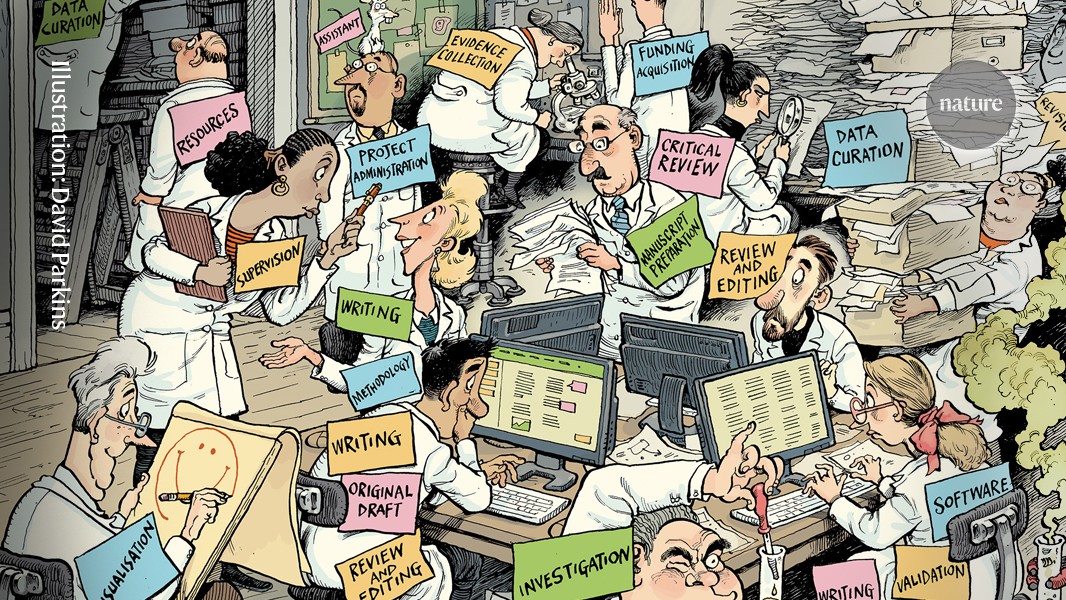A decade ago, we and others launched a tool for clarifying the roles of each author of a research paper. The Contributor Role Taxonomy (CRediT) includes 14 types of contribution, from conceptualization to software and data curation. It was designed to prevent questionable authorship practices and make it easier for researchers to demonstrate the diversity of their contributions to science, among other benefits.
Credit where credit is due
This year, taking stock, we’ve shown that adoption has risen steadily (see ‘More CRediT is being given’)1. By 2024, CRediT information was included in nearly 850,000 publications (encompassing articles, preprints and conference papers) — around 22% of the 3.7 million publications recorded last year in Digital Science’s Dimensions, a database of scholarly publications.
This level of uptake is remarkable, given that there have been no coordinated efforts or mandates from publishers and funders. But the issues that the taxonomy was conceived to tackle remain rampant in the research literature. Here we call for CRediT to become the norm, to support researchers and research integrity across the whole academic landscape.
CRediT is still needed
Despite widening use of CRediT, authorship conventions in scholarly publishing remain opaque and confusing, and differ by discipline. They typically provide little to no information about who contributed what in a study (see ‘The parts we played’). A name’s position in a list of authors is an unreliable indicator of the significance of that person’s work or the time they spent, particularly when the author list is long or alphabetical, as is common in economics2 and for large collaborations, and as also occurs in biomedical research3.
Stop treating code like an afterthought: record, share and value it
Questionable practices, such as including honorary authors, who are named but have not contributed, and excluding ‘ghost authors’, who have contributed but are not named, also remain prevalent — perhaps occurring in as much as one-fifth of biomedical papers4.
Meanwhile, the volume of misconduct allegations and retractions in research is skyrocketing. When results are questioned after publication, transparency as to who did what helps investigators, supports accountability and can help to foster a responsible authorship culture more generally5.
CRediT data can also be used to inform policy interventions that help to drive innovation, equity and impact in science. Data on author contributions have been used to study gender and the division of labour in research6,7, as well as variations in the distribution of roles across disciplines8, for example.

Source: Analysis by L. Allen et al.
The tool can help institutions and funders to identify skills being used in cutting-edge fields. Institutions could use the taxonomy to analyse the contributions of their researchers and identify talent that should be retained and developed. Funders can identify specialists — such as data scientists or research software engineers — for targeted funding opportunities or to serve as expert peer reviewers.
Initiatives such as the San Francisco Declaration on Research Assessment (DORA), launched in 2012, and the Coalition for Advancing Research Assessment (CoARA) now champion the need to consider diverse contributions to research when assessing individuals’ performance9. And the value of CRediT is increasingly acknowledged by science organizations such as the UK Academy of Medical Sciences. In 2022, the taxonomy became a recognized standard of the US National Information Standards Organization (NISO) and the American National Standards Institute (ANSI) — meaning that publishers and other stakeholders internationally are encouraged to adopt it.
Roadblocks to progress
Despite the need for CRediT, further progress is held back by the changing research landscape, a lack of resources and inconsistent implementation.
The use of CRediT has spread across disciplines and geographies1 — indicating that it strikes a chord. But some roles might fall outside the original 14 or be better represented by improving definitions of the existing roles, especially in fields such as social sciences and engineering, which were under-represented in the corpus of publications used to develop the taxonomy. For example, community engagement is becoming an increasingly important role as researchers strive to improve relationships with study participants, and because of citizen science. The CRediT term ‘software’ might need to be expanded to better reflect infrastructure development and data science. And the spread of new technologies, such as AI, could also alter the roles of scientists across the research landscape, from hypothesis generation to the writing-up of results.




